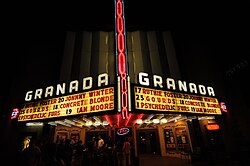 Exterior of venue | |
 Interactive map of Granada Theater | |
| Address | 3524 Greenville Ave. Dallas, TX 75206-5630 |
|---|---|
| Coordinates | 32°49′51″N96°46′12″W / 32.830702°N 96.770024°W |
| Capacity | 1,000 |
| Current use | Concert venue |
| Construction | |
| Opened | 1946 |
| Architect | Raymond F. Smith |
| Website | |
| granadatheater | |
The Granada Theater is a theater in the Lower Greenville neighborhood of Dallas. The theater was built in 1946 as a movie house. In 1977, it was converted to a concert hall, only to revert to a movie theater soon afterwards. In 2004 it was again opened as a concert hall.

